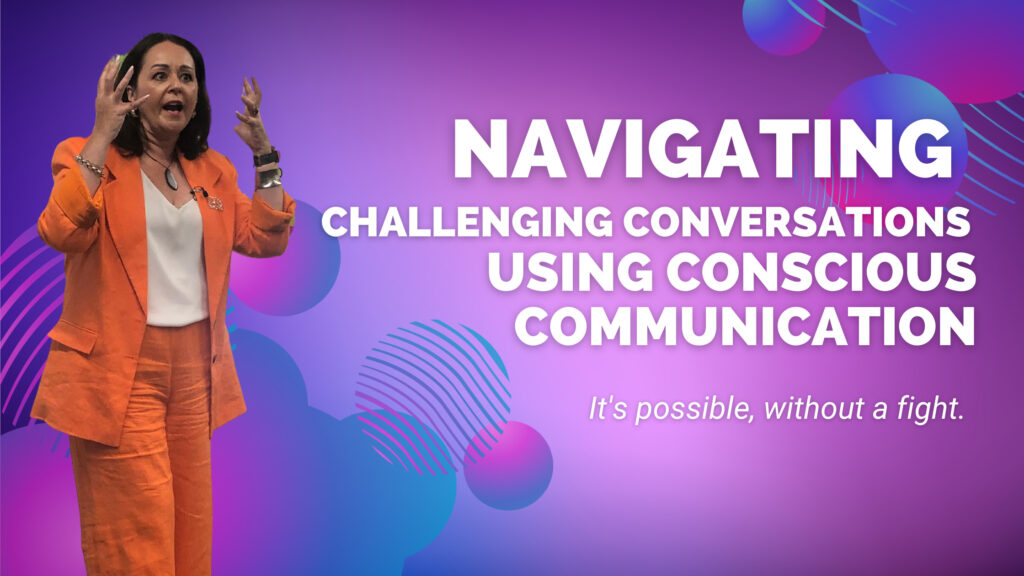Navigating Challenging Conversations using Conscious Communication

Navigating Challenging Conversations using Conscious Communication
Having challenging conversations is an inevitable part of life. Whether it’s addressing conflicts, discussing sensitive topics, or providing constructive feedback, these conversations can often be uncomfortable and emotionally charged. However, by employing the principles of conscious communication – clarity, context, active listening, intention, curiosity, and presence – we can navigate these discussions with empathy, understanding, and positive outcomes. In this article, we explore effective strategies that I teach to groups, organisations and individuals on how to have challenging conversations while fostering growth, connection, and mutual respect.
Cultivate Clarity
Before initiating a challenging conversation, it’s crucial to clarify your own thoughts, emotions, and intentions. Take time to identify the core issue, understand your own perspectives, and clarify the outcomes you seek from the conversation. When you approach the conversation with a clear mindset, you can articulate your thoughts more effectively and avoid unnecessary misunderstandings. Change starts with you.
Set the Context
Context is essential in any conversation, particularly in challenging ones. To achieve this it’s important to simply ask more questions. Create a safe and comfortable environment that encourages open dialogue. Establish ground rules, such as active listening, respectful communication, and the willingness to consider different viewpoints. Setting a positive and supportive context allows all parties to express themselves without fear of judgment or hostility.
Practice Active Listening
Active listening is the cornerstone of conscious communication. It involves giving your full attention to the speaker, seeking to understand their perspective without interrupting or formulating responses prematurely. During challenging conversations, listen empathetically and suspend judgment. Reflect back on what the speaker has said to ensure understanding and validate their feelings. By truly hearing and acknowledging their thoughts and emotions, you foster a sense of trust and create a conducive environment for meaningful dialogue. Remember: communication is a feedback loop. It’s important to both talk and to listen.
Set Positive Intentions
Approach challenging conversations with positive intentions, emphasising the desire for mutual understanding and growth. Shift your mindset from confrontation to collaboration. When both parties approach the conversation with goodwill and a shared goal of resolving conflicts or finding solutions, it becomes easier to find common ground and work towards a constructive outcome. In some cases, working with an impartial 3rd party or moderator can be helpful.
Cultivate Curiosity
Maintaining a curious mindset is essential during challenging conversations. Instead of assuming you know all the answers, approach the discussion with a genuine curiosity to learn from the other person’s perspective. Again: ask open-ended questions that encourage deeper insights and promote self-reflection. By seeking to understand the other participants underlying motivations, values, and experiences, you can uncover commonalities and bridge gaps in understanding.
Embrace Presence
Presence is the art of being fully engaged and attentive in the present moment. During challenging conversations, practice mindfulness, breathe, switch off your mobile devices and be aware of your own emotions and reactions. Stay present with the speaker, focusing on their words and non-verbal cues. Avoid distractions and avoid the urge to jump to conclusions or make assumptions. By embodying presence, you create a space for authentic connection and foster empathy and understanding.
Engaging in challenging conversations can be daunting, but by applying the principles of conscious communication, we can transform these discussions into opportunities for growth, understanding, and deeper connections. Through clarity, context, active listening, intention, curiosity, and presence, we can navigate these conversations with grace and empathy, fostering healthy relationships and resolving conflicts constructively. Remember, the power of conscious communication lies in our ability to create an environment where everyone feels heard, valued, and respected. Speak, listen and seek to understand.

